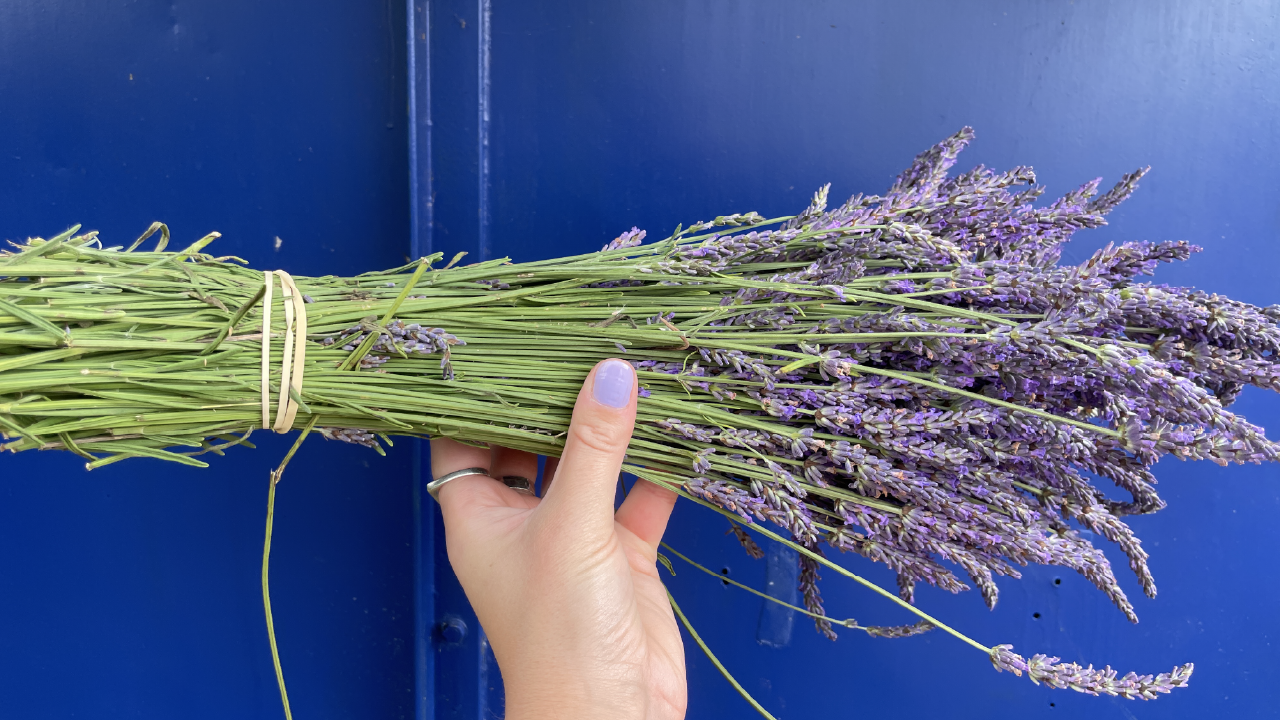
18, August 2025
How to Dry Lavender
If you’re lucky enough to have a lavender plant, you’ll be familiar with the beautiful aroma it brings to your garden in summer. The soothing scent of this bee-friendly plant is known promote feelings of relaxation (why our Kent-grown lavender essential oil is one of our favourite ingredients!). By harvesting and drying the flowers at the right moment, you can keep enjoying the amazing aroma and benefits of lavender all year round.

YOU WILL NEED:
- A lavender plant
- Secateurs or sharp scissors
- Elastic bands
- A paperclip
WHEN TO HARVEST LAVENDER
The best time to cut lavender for drying is just before it’s in full bloom, when about 25% to 50% of the buds on the flower spikes are open. This is when the essential oils are at their most potent. It could be in July or August, depending on the variety of the plant.
Always harvest on a dry day to reduce the risk of mould. Gather in early afternoon, when the morning dew has dried and the essential oils are said to be at their best.

DRYING LAVENDER
Here’s a step-by-step guide to harvesting and drying your lavender.
1. GET READY
Make sure your secateurs or scissors are clean, to avoid transferring any diseases from other plants. Wait until about midday on a warm, dry day.
2. SNIP YOUR STEMS
Carefully cut the flower stems just above a set of leaves. If you’re drying lavender to make bouquets, cut stems of about 15-20cm. Want to use the flowers for lavender bags? You’ll only need stems of about 10cm.
3. BUNDLE UP
Use an elastic band to secure your stems in bunches. Garden twine might look prettier, but your lavender stems will shrink as they dry and elastic will keep them securely bunched together.
4. TIME TO HANG
Open a paperclip to make a hook and use it to hang the lavender upside down somewhere cool, dark, dry and well-ventilated. It should take about one to two weeks for your lavender to completely dry out.
5. IT’S READY!
After a week or two, see if your lavender has thoroughly dried out. Check the stems: if they snap rather than bend, they’re ready. If you want a dried bouquet, you can arrange your stems in a vase straight away. For lavender bags, gently strip the flowerheads from the stems with your thumb and forefinger. Store the dried flowerheads in a jar in a dark place until you need them – this will help preserve that wonderful scent and the rich purple colour.

WHEN IS IT TOO LATE TO HARVEST LAVENDER?
You can still harvest lavender flowers that are already fully open, or even those that have started to fade – just bear in mind that both the colour and aroma will be much less vibrant than earlier blooms. When the flowers have fully wilted, they’re way past their aromatic peak and not worth harvesting. But you can still cut them: pruning your lavender in early autumn should encourage it to produce more new flowers next summer.
WHAT TO DO WITH DRIED LAVENDER
So, you’ve got jars full of incredible-smelling dried lavender flowers, now what are you supposed to do with them? There are plenty of uses for dried lavender around the home – and it even makes its way into food and drink recipes. But most people harvest lavender for its scent.

LAVENDER BAGS
One of the easiest ways to get the best out of your dried flowerheads is to make lavender bags. These small pouches burst with lavender’s distinctive aroma, which is known to help promote rest and relaxation – and is believed to be natural moth repellent. Lavender bags can be hung in cars, popped in drawers, tucked under pillows and given as gifts.
HOW TO MAKE LAVENDER BAGS
There are lots of guides on how to make lavender bags online. The golden rule is to use breathable fabric: cotton, muslin, linen or organza, so the aroma of the lavender can flow out of the bag. You might have some of these fabrics lying around the house already – this is a great excuse to upcycle old pillowcases, t-shirts and more. Keep hold of any small, drawstring gift pouches and reduce waste by repurposing them as lavender bags.
You don’t have to be good at sewing to make lavender bags. Try sprinkling the dried flowerheads in the middle of a 20cm square of fabric and tying at the top, like a Japanese furoshiki wrap. If you’re more about function than form (and you’re short of time), fill an ankle sock or baby sock with your dried flowerheads and tie it closed with ribbon or string.
Enjoyed this? You might like:
How to Grow Mint Plants that Just Keep Giving
Save the Bees: Protecting Our Precious Pollinators




